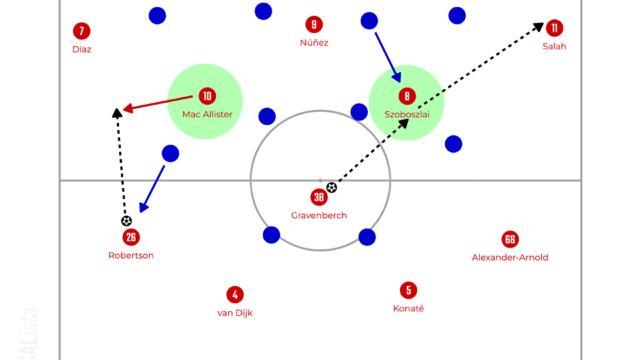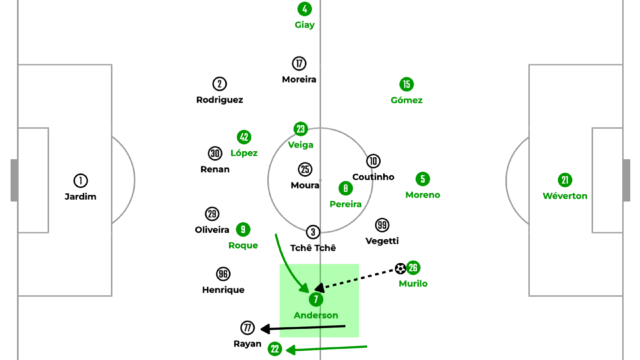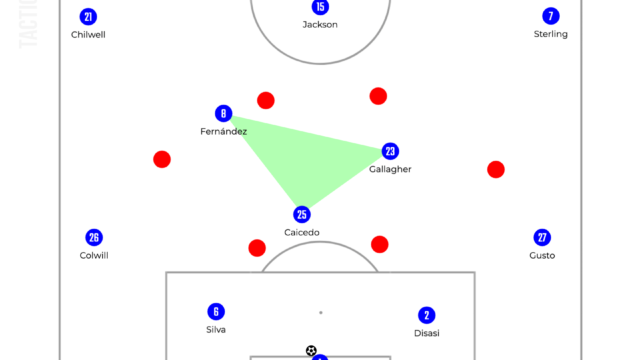FC Internazionale Milano Tactical Analysis 22-23 [Simone Inzaghi’s Solidest Team in Europe]

Introduction
Right now, when I am writing this article, Inter have two goals lead against their biggest rival in the city in the first leg of the semi-final in UEFA Champions League this season. It can be a memorable season for them if they win the local derby in the semi-final and UCL trophy, though either of Manchester City or Real Madrid is waiting for them. Simone’s team is extremely realistic, avoiding risks and killing the opponents at the right moment. In this article, the tactics of Inter Milan will be analysed. I hope you will enjoy it.
In Possession
In possession, Inter prefer to play out from the back with the superior ability of distribution of the goalkeeper, André Onana. Especially in the case when the opposition team tries to press high with man marking, they play over to Edin Džeko to break the lines and exploit the huge space around the opposition back line, this is one of their main weapons.
Build up
The basic structure when playing out from the back is shown in the illustration below.

Mainly, the right wingback Denzel Dumfries steps up higher than the opposite wingback, so the system is asymmetrical. The key players when keeping the possession at the back are the central centre back Francesco Acerbi and the defensive midfielder Marcelo Brozović. They adjust their positions flexibly to create a passing lane in front of the goalkeeper and receive a split pass from Onana. This line breaking pass can force the opposition attackers up front to turn their body angle 180 degrees and stop their pressing. This is the main reason why it is difficult to press high against Inter. Additionally, especially Brozović’s work is amazing. He moves from one side to the other quickly to help the wide centre backs by offering a horizontal passing lane to retain the possession. Even if these efforts are not enough, the right attacking midfielder Nicolò Barella drops back to offer additional passing lane.
Usually, Inter can create a spare player who can face forward with the ball behind the opposition first line and he will switch the ball and the team can progress. However, another strength of them is playing over simply when the opposition team press more aggressively.

The long ball towards Džeko or Romelu Lukaku is simply unstoppable. They can hold the ball up or lay it off to one of the attackers. Importantly, when the opposition team is pressing high even with their midfielders, the space between the lines is massive. Thus, the other striker Lautaro Martínez or one of the attacking midfielders overlapping can pick the ball up there and play fast attacks to break the opposition back line in huge space. Additionally, the right wingback Dumfries often stays up front and is ready for running in behind, which is also a great threat against the opposition back line.
Overall, considering the ability of key players such as Onana, Brozović or Džeko, the selection of tactics is balanced, in other words, they do not stick to one idea, which is like only playing short or only playing over. This makes Inter realistically strong in terms of playing out from the back.
Final Third Attacking
In the final third, they do not do complicated things. Playing in wide areas and delivering crosses is the main thing to do.
Both wide centre backs, Alessandro Bastoni and Matteo Darmian are really aggressive in the final third. Especially Bastoni has a great ability on the ball, so it is often seen that he carries the ball forward, delivers a cross and gets an assist. Additionally, in the box, the tall striker, one of the attacking midfielders and the opposite side wingback are ready to head the ball into the back of the net. So overall, thanks to the advance of one of the wide centre backs, it is possible to dominate the wide area and there are enough players in the box, so simple crosses can be the best option for them.

Of course, however, as one of the centre backs steps up, the number of defenders might be not enough to manage the opposition counterattacks. To cover this, Brozović always finds the gap at the back and fill the space up to prevent them from exploiting the gap. Additionally, as a team, the overall reaction when losing the ball is quick enough to prevent them from playing accurate ball forward. Therefore, Inter can avoid being played counterattacks even though they are so aggressive in the final third.
Out of Possession
When pressing high, they are so aggressive with man marking, but they are willing to set a block of the 5-3-2 in the midfield or own half. Against AC Milan in the first leg of the semi-final, their aggressive pressing gave them the advantage, but setting a block is more usual than that.
Pressing
In the game against AC Milan, the most important thing was that the system was well matched. All players clearly had a man to mark, which made it easier to press high with that intensity. So, what will happen when the opposition team plays with a back three or single pivot which do not match Inter’s system?

In terms of the game against teams with a back three and single pivot, it is often a job for Barella to jump to press the opposition spare centre back and the other attacking midfielder apply pressure on the opposition pivot. After the pressing is beaten, which often happens when the opposition team successfully switches the ball to the other side, Inter set a solid block in the midfield. They are willing to give up pressing high.

This 5-3-2 is one of the hardest defensive blocks to break down in Europe. The back five tends to focus on marking the opposition attackers in between lines and prevent them from receiving the ball there and turn forward. Additionally, the midfield three is also hard-working and close the gap between them while keeping shuffling across from one side to the other.
The counterattacks from winning the ball in the midfield or own half is another threat of them. One of two strikers drifts wide to receive the ball in behind or one of the attacking midfielders or wingbacks carries the ball forward in order to play quick counterattacks. Their focus on progressing the ball forward as soon as winning the ball is extremely high and it is often seen that one of the attacking midfielders arrives at the space around the edge of the box to finish the counterattacks from cutbacks as Henrikh Mkhitaryan did against AC Milan.
Final Third Attacking
It is almost impossible to break the 5-3 block around the box down. This is not only because of the number of defenders there but also the quality of centre backs. However, there is a weakness to be exploited well.

Usually, three defenders of the central centre back, the opposite side centre back and wingback stay in front of the goal against crosses and three midfielders work hard to cover space between gaps. However, if the opposition team creates an overload in wide areas, the central centre back could be dragged out to follow the principle of man marking. This can make it weaker the defence in front of the goal especially against crosses and SL Benfica scored a goal from a cross by exploiting this weakness. Thus, it will be a key for the opposition team to create an overload in wide areas.
Conclusion
Overall, Inter is a realistic and strong team who deserves to be in the semi-final of UCL and more. Simone’s men can play simply but effectively and also work hard. This one of the solidest teams in Europe can win UCL, but it is never miracle. Thank you for reading. I hope you enjoyed it.


